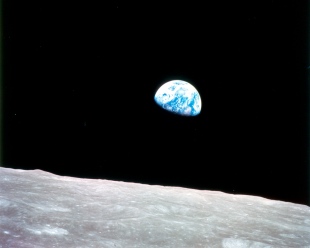
This is a meander, rather than a construction. If it were a house, it would probably fall down. No foundation, no plumbing, no two-by-fours holding up the walls. Just a set of connections, some things that grouped themselves together around an image.
It started with Jon Udell’s essay, published on May 17, 2011, called “Awakened Grains of Sand.” I didn’t read the essay until much later. I’d marked it in an RSS reader, and then sent it to my Text DVR, Instapaper, to read at a later date. In the essay, Udell makes another attempt to explain what he calls “web thinking.” By coming back to this subject again and again, he teases out new threads, new aspects of the real shape of what we call the virtual. His work with calendars, analog and digital, pinpoints a space where a potential connection is missed. Generally speaking, different kinds calendars can’t seem to talk to each other.

It was Udell’s use of ‘grains of sand’ as a metaphor that caught my attention.
In a recent talk I failed (spectacularly) to convey the point I’m about to make, so I’ll try it again and more carefully here. We can make about as many 14-character tags as there are grains of sand on Earth. True, a lot of those won’t be nice mnemonic names like WestStDamKeene, instead they’ll look like good strong unguessable passwords. But there are still unimaginably many mnemonic names to be found in this vast namespace. Each of those can serve as a virtual bucket that we can use to make and share collections of arbitrarily many web resources.
The implications take a while to sink in. Grains of sand are inert physical objects. They just lie around; we can’t do much with them. But names can be activated. I can create a 14-character name today — actually I just did: WestStDamKeene — that won’t be found if you search for it today on Google or Bing. But soon you will be able to find at least one hit for the term. At first the essay I’m now typing will be the only hit from among the 30 billion indexed by Google and 11 billion indexed by Bing. But if others use the same term in documents they post to the web, then those documents will join this one to form a WestStDamKeene cluster.

This took me in two directions. The idea of a grain of sand as an inert physical object in relation to a system of meaning, or set of web services, first pulled in thoughts of Saussurean linguistics and the idea of the arbitrary nature of the signifier in relation to the signified. But a stronger pull was exerted by the opening stanza of William Blake’s poem from 1803, “Auguries of Innocence.”
Auguries of Innocence
William BlakeTo see a World in a Grain of Sand
And a Heaven in a Wild Flower,
Hold Infinity in the palm of your hand
And Eternity in an hour.A Robin Redbreast in a Cage
Puts all Heaven in a Rage.
A dove house fill’d with doves and pigeons
Shudders Hell thro’ all its regions.
A Dog starv’d at his Master’s Gate
Predicts the ruin of the State.
A Horse misus’d upon the Road
Calls to Heaven for Human blood.
Each outcry of the hunted Hare
A fiber from the Brain does tear.
Blake starts with the tiny inert physical object and from it he conjures the whole universe. Udell’s grains of sand have the potential to combine into legible sequences and encode some specific meaning, or refer to an assembly of services. Blake uses parts to stand in for wholes, a rhetorical figure known as synecdoche. An augury is a sign or an omen.
The poet Robert W. Service, known as the Bard of the Yukon, also makes use of the ‘grain of sand.’ While he’s best remembered for “The Cremation of Sam McGee,” in a poem written in the 1950s, he travels the dangerous territory first marked out by Giordano Bruno. If Blake sees the world in a grain of sand, Service notices that the beach is filled with sand. Each grain might be a world, a constellation, a universe. A million grains of sand quickly makes the leap to infinity.

A Grain of Sand
Robert W. ServiceIf starry space no limit knows
And sun succeeds to sun,
There is no reason to suppose
Our earth the only one.
‘Mid countless constellations cast
A million worlds may be,
With each a God to bless or blast
And steer to destiny.Just think! A million gods or so
To guide each vital stream,
With over all to boss the show
A Deity supreme.
Such magnitudes oppress my mind;
From cosmic space it swings;
So ultimately glad to find
Relief in little things.For look! Within my hollow hand,
While round the earth careens,
I hold a single grain of sand
And wonder what it means.
Ah! If I had the eyes to see,
And brain to understand,
I think Life’s mystery might be
Solved in this grain of sand.

Today we speak easily about the possibility of multiple universes, for Giordano Bruno, those thoughts ended in imprisonment and eventually execution. On February 17, 1600, Bruno was burned at the stake for his explorations into the expanses of infinity:
Whatever is an element of the infinite must be infinite also; hence both Earths and Suns are infinite in number. But the infinity of the former, is not greater than of the latter; nor where all are inhabited, are the inhabitants in greater proportion to the infinite than the stars themselves.
Blake sees the world in a grain of sand, Bruno says that whatever is an element of the infinite must be infinite also. For Saussure, the arbitrary nature of the phoneme means that a signifier has no necessary link to the signified. Udell can chain together a sequence of grains of sand and point them at any object, or collection of objects, in the universe. The sleeping and withdrawn grains of sand are awakened when this link is made.
After finishing Udell’s essay, I was also taken with its resonances to my post: Going Orbital: Content and its Discontents. Where Udell tries to explain ‘web thinking,’ I try to examine the differences between the practice of the analog and the digital. It’s a strange land where a thing is a copy at its origin; and by moving it from here to there another copy is created. Even the act of reading it creates another copy. These things have no fixed position, and appear to exist simultaneously in multiple locations—a kind of every day non-locality.

In thinking about this leap from the analog to the digital, Udell considers the example of calendar entries. But another example of this figure pulled itself into this constellation of thoughts. In Ian Bogost’s book, Unit Operations, An Approach to Videogame Criticisim, he recounts some of the early history of computers and computation:
Among the first true high-speed electronic digital computers, ENIAC’s main disadvantage was a considerable one: it contained programmatic instructions in separate segments of the machine. These segments needed to be properly plugged together to route information flow for any given task. Since the connections had to be realigned for each new computation, programming ENIAC required considerable physical effort and maintenance. Noting its limitations, in 1945 ENIAC engineer and renowned mathematician John von Neumann suggested that computers should have a simply physical structure and yet be able to perform any kind of computation through programmable control alone rather than physical alteration of the computer itself. …Stored-programming makes units of each program reusable and executable based on programmatic need rather than physical arrangement. Von Neuman, Eckert, Mauchley, and Goldstine designed a control instruction called the conditional control transfer to achieve these goals. The conditional control transfer allowed programs to execute instructions in any order, not merely in the linear flow in which the program was written.
In this figure, the move from the analog to the digital takes the form of moving from a physical model of computing to a logical model. Here too, we need to take a leap in our understanding of location and how a thing occupies space. The world can be loaded into a grain of sand, and the grains of sand rearranged in arbitrary patterns.
“Our Age of Anxiety is, in great part, the result of trying to do today’s jobs with yesterday’s tools!”
— Marshall McLuhan
While it’s bound to continue on, the latest stop in this chain of thought is with Apple’s iCloud and the end of the file system. The desktop and file folder metaphor breaks down once you find yourself trying to keep things in sync across multiple devices. Source and version control software isn’t a part of the common tool set. This is part of the ‘web thinking’ that Udell has had such difficulty in getting across. Part of the problem is the metaphors we have at our disposal. A metaphor is literally “to carry over.” A broken metaphor no longer carries over, the sense leaks out as it crosses the chasm.
It’ll be interesting to find out whether this transformation can take place without explanation, outside of language. If whatever you’re working on, or listening to, just shows up where ever you need it. That could be enough, understanding it may be beside the point. Does magic need an explanation? The work of synchronization and versions isn’t something you do, it’s just the way certain kinds of digital things behave. If it catches on, we’ll start wondering why all digital things don’t behave that way.
8 Comments










